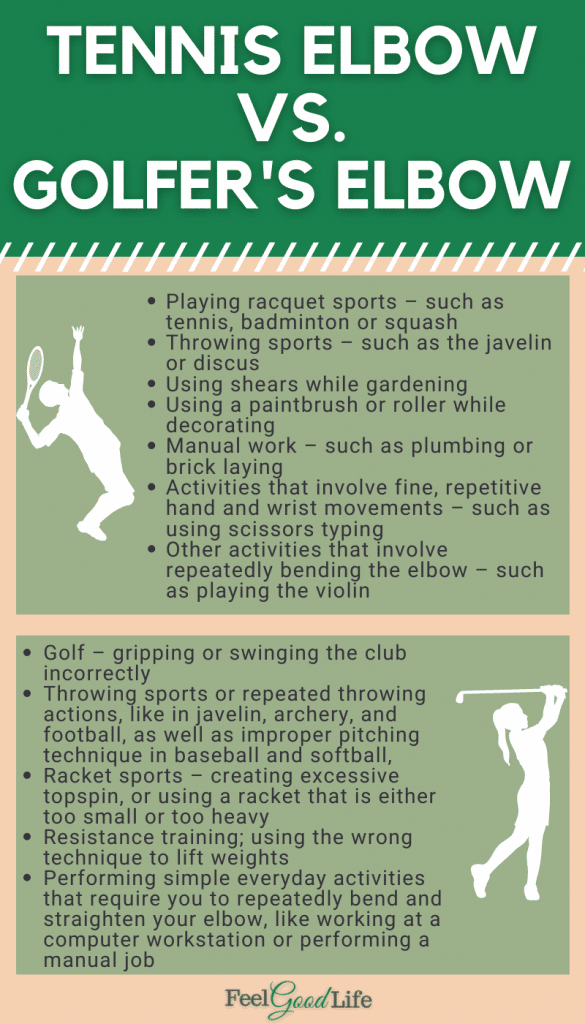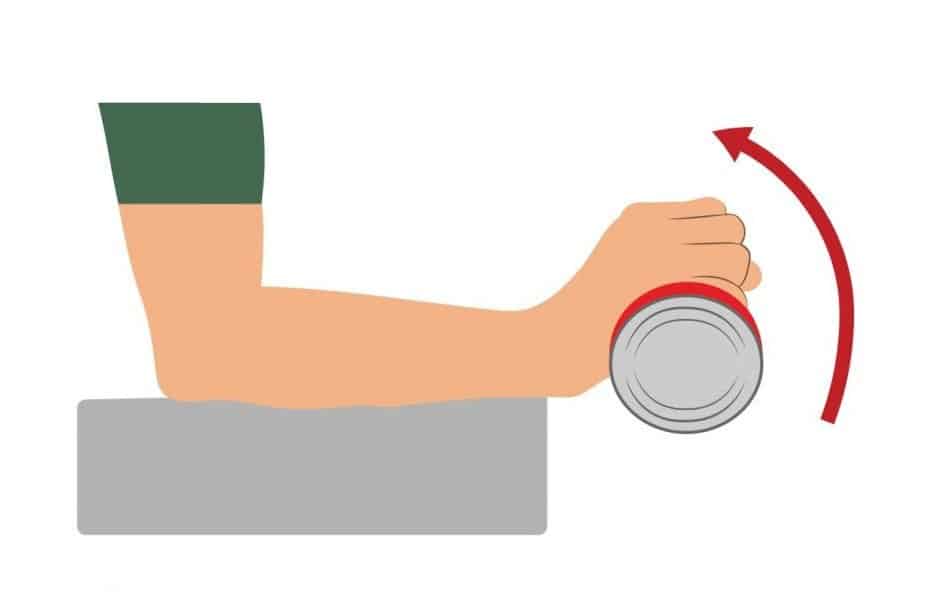Free download: Top 10 Natural & Easy Remedies for Joint Pain from Home. Learn these helpful remedies.
Estimated Reading Time: 6 minutes read
When suffering from elbow pain, such as elbow tendonitis (tennis elbow or golfer’s elbow) grabbing a pack of ice might not be your best option. Instead, try my 5 elbow exercises for tendonitis.
Many injury treatments begin with the oh-so-common R.I.C.E technique… however this isn’t always the most effective treatment, especially when treating overuse injuries such as tennis or golf elbow.
According to a 2008 study, “There is insufficient evidence to suggest that cryotherapy improves clinical outcomes in the management of soft tissue injuries.”
Cryotherapy, or the use of extreme cold, reduces the pain signals in the body and has long been touted as the perfect anti-inflammatory.
Unfortunately, the body’s inflammation process is needed in order to trigger the proper healing mechanisms.
When it comes to soft tissue injuries, inflammation is the body’s way of attempting to heal the following:

This type of soft tissue injury happens when the extensor tendon of the wrist (that attaches just above the elbow) is overused and becomes inflamed in order to generate more blood flow to the area.
Tennis elbow is often characterized by pain outside of the elbow.

This type of soft tissue injury happens when the flexor tendon of the wrist (that attaches just above the elbow) is overused and becomes inflamed in order to generate more blood flow to the area. Golfer’s elbow is often characterized by pain inside part of the elbow.
Table of Contents
Elbow Pain Causes That Lead to Tendonitis
Both of these soft tissue injuries are often caused by repetitive activity.
The trauma and inflammation slowly build over time until even the slightest movement leads to pain.
If you perform any of the following activities for more than an hour a day, multiple days a week, you could be at risk of Tennis or Golfer’s Elbow:

Many of these movements will lead to pain and tenderness either along the inside or outside of your elbow joint.
Before the pain and tenderness, though, you may feel some weakness or stiffness in both the elbow and the wrists.
However, if pain ensues, numbness or tingling may follow, radiating into one or more fingers.
Luckily, here are some things you can do to help reduce pain and avoid these overuse injuries.
Step One to Decreasing your Elbow Pain: Change How You Move
The first thing to do if you have elbow pain is to change, or possibly stop, any movements that might be causing your symptoms or making them worse.
For instance:
- Instead of carrying your purse in your hand, switch to a crossbody bag.
- If opening the door with your left-hand hurts, try using your right.
- Improve your technique on golf and racquet swings.
- Drop weight during resistance training.
Step Two to Decreasing your Elbow Pain: Try These 5 At-Home Elbow Exercises for Tendonitis
The following elbow exercises for tendonitis will slowly help draw blood into the soft tissue area, shuttling nutrients, and other needed items to help start the natural healing process.

1. Spoon Massage
Scraping therapy is a manual type of treatment, in which a tool is used to scrape the skin and improve the area’s circulation. This also assists in creating a healthier soft tissue healing environment.
Grab a spoon with a flat handle (no flare or flashy design at the end) and some lotion. Rub the lotion on the affected forearm to help lubricate the path of the spoon edge.
Holding onto the round portion of the spoon, gently run the flat edge along the arm, following the muscle direction (from elbow to wrist).
Repeat this scraping process, adding more pressure each time. Keep scraping until your arm begins to turn red — as soon as you see the color change, move to a different area along the arm or finish completely.
2. Soup Can be Strengthening
The next two movements will isolate the wrist flexors and extensors. Wrist flexion pushes your hand towards the bottom side of your arm and wrist extension pulls your wrist towards the top of your forearm. Each can be trained using a soup can.

Wrist Lifts: Sit in a chair with a soup can in your hand with your palm facing down, and put your elbow on the arm of a chair (your knee) comfortably.
Keep your palm facing down, and lift your wrist toward your body by curling it. Slowly return to the starting position (this is the most important part of the exercise).
Isolate the motion to the wrist, leaving the remainder of the arm still. If this is too hard, perform the movement without any weight first.
Repeat 10 times.

Wrist Curls: Sit in the same position as above. Hold your palm face-up, lift your wrist toward your body by curling it. Slowly return to the starting position.
Remember to isolate the wrist, just as you did with the wrist lifts exercise.
Repeat 10 times.
3. Towel Twist
This next movement continues to work the flexors and extensor muscles in your forearm as well as strengthening your grip.
A powerful grip helps the wrist from over-working. Also, continuing to target the flexors and extensors eases stress on your elbow joint.

Sit in a chair holding a towel between both hands. Keep your shoulders relaxed but maintain a good posture.
Twist the towel in opposite directions — flexing one wrist and extending the other — as if you are wringing out water.
Repeat 10 times then repeat another 10 times switching the directions of your hands.
4. Tennis Ball Squeezes
Improving your grip strength can contribute to improved power, agility, and resistance to elbow and wrist injuries. This next movement will isolate strengthening your grip.

Sit at a table, leaning on the edge with your forearm. Grab a tennis ball in the palm of your hand.
Squeeze your hand into the tennis ball and hold for 10 seconds. Release and repeat 10 times.
If this becomes too easy, create a bigger gap between your fingers — the bigger the gap, the greater the challenge.
5. Rubber Band Strengthening
Manual dexterity is the ability to use your hands to grab and manipulate objects in a skillful, synchronized manner and to show quick, precise movements.
Tasks such as this exercise improve fine motor skills, increase muscle strength in the fingers, hands, and wrists, while also improving coordination.

Grab a hair tye or rubber band and place it around each one of your fingers (not your thumb).
Gently spread your fingers out wide, stretching the band sideways. Slowly return to the starting position, and repeat 10 times.
These elbow tendonitis exercises are a great starting point that will work better than the traditional R.I.C.E method to relieve elbow pain from lifting, gripping, and general overuse.
It’s also important to remember to do general strengthening along with these targeted exercises.















